Of all my habits that help infuse and foster my creativity, journaling is my most valued. I was a big diary kid growing up, influenced by Doug Funnie and Harriet the Spy, with a lot of solo time on my hands as an only child. I’ve always had a lot of feelings that need somewhere to go, paired with high anxiety that needed some kind of release. While I’ve aged out of the puffy plastic diary with a heart shaped lock, the habit has grown up with me.
There are countless creative benefits that come from journaling. It’s a great way to work through an idea, to let out frustrations and disappointment, to clear out the cobwebs before you dive into a project. It can be a playground for your thoughts - a safe space to explore ideas and impulses before committing to them. It can be a useful tool for problem solving and goal setting.
Journaling can also be great for your health. I use it to manage my anxiety and stress levels, and it’s been proven to help with depression, support recovery, and improve your mood. It encourages self-reflection, helps regulate emotions, and has even proved helpful in lowering blood pressure.

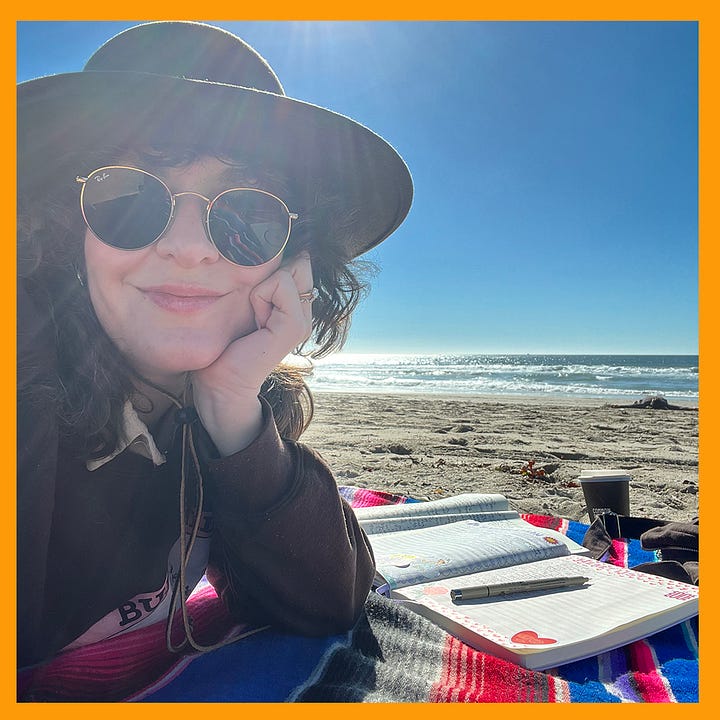
There are so many different ways to journal, so I’m just going to highlight the three styles/methods that I personally use, along with tools and tips that I swear by. I hope this is an inspiring jumping off point for anyone who wants to cultivate a new journaling habit, or that it provides some insight for veteran journalers as well.
In author Julia Cameron’s quintessential text on creativity, The Artist’s Way, she writes (some would argue ad nauseam) about “morning pages” - a journaling process in which you fill three pages first thing when you wake up.
Often called stream-of-conscious, brain dump, or “automatic” writing, the term “free writing” emerged in the 1970s; this style of journaling involves putting pen to paper for a designated period of time or length of pages without censoring, editing or controlling your thoughts. As a teenager, I had a theatre camp counselor who called it a “brain drain” and would have us dump our thoughts onto paper before we started rehearsals: get everything out before going on stage.
No matter how you decide to do your pages, the important part is you release yourself from judgement. No one will see these; YOU never even have to read them. Its about the journey, not the destination. If you uncover something amazing or have a breakthrough - wonderful. Otherwise, this is just like stretching before the real workout.
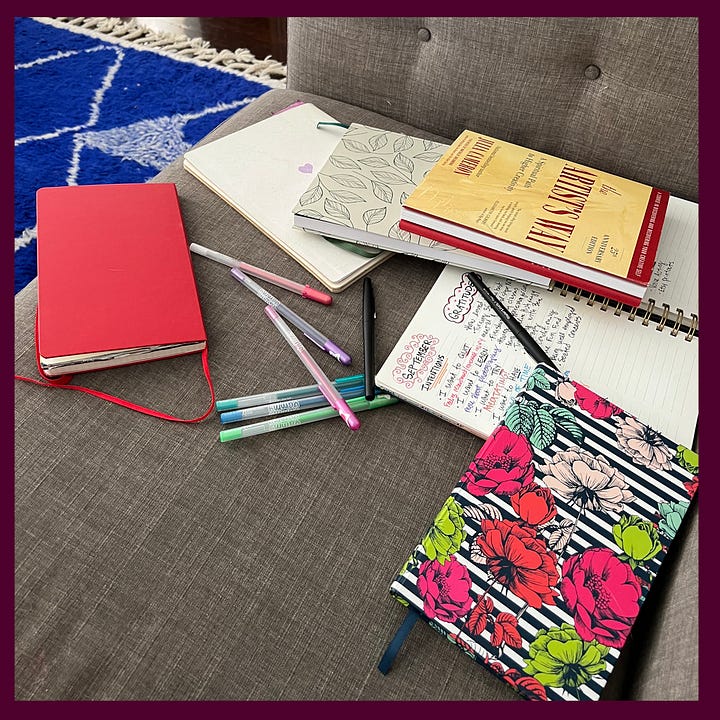
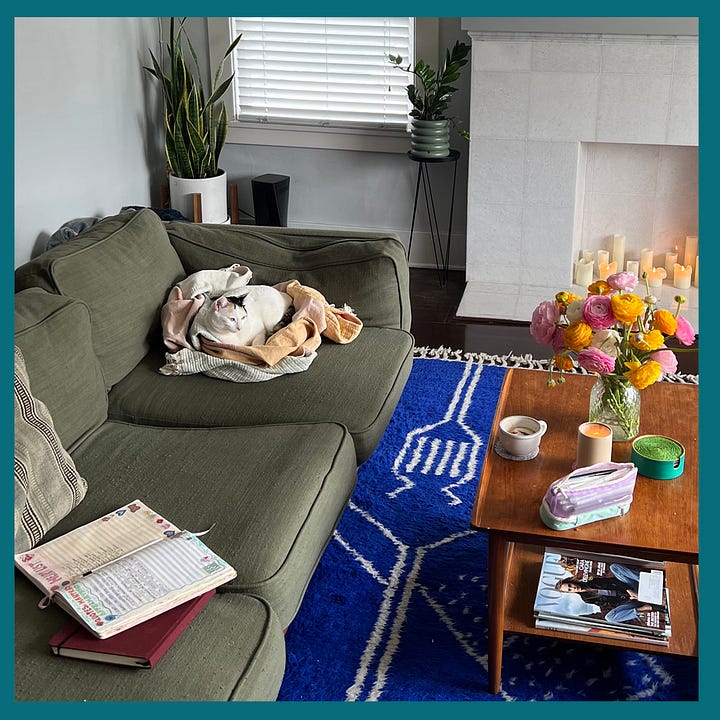
“We are victims of our own internalized perfectionist,” Cameron says. “A nasty internal and eternal critic, the censor, who resides in our (left) brain and keeps up a constant stream of subversive remarks that are often disguised as the truth… Make this a rule: always remember that your censor’s negative opinions are not the truth. This takes practice. By spilling out of bed and straight into the page every morning, you will learn to evade the censor.”
It’s worth mentioning that Cameron insists there is no wrong way to do the pages. Adapt it for yourself in a way that works. That could look like doing one page instead of three, doing it just on weekend mornings when you have the time to relax into the process, or even doing them at night as a brain drain when you sign off of work.
I find the restrictions helpful: fill up three pages even if you feel you have nothing to say. Especially when you have nothing to say. I almost never re-read anything I’ve written, but I can guarantee you there are pages about how much I love my cat.
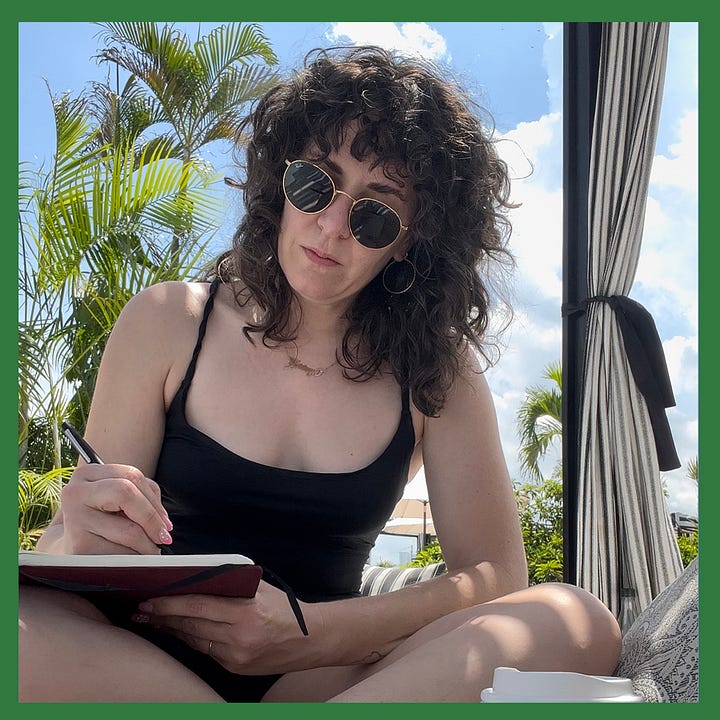
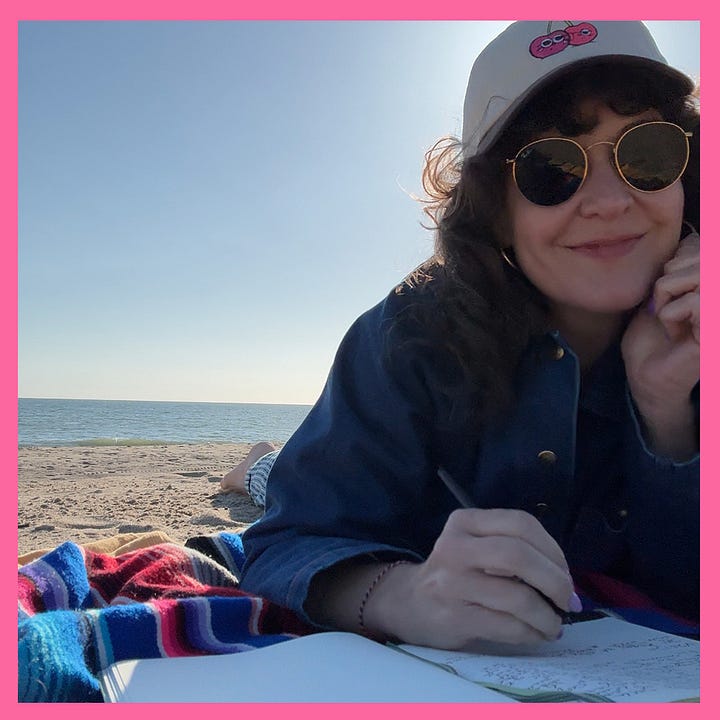
“What do I write about? Where do I start? What if I can’t think of anything?” are the questions I most often receive when people ask me about my practice. The answer is: literally whatever pops into your head. It doesn’t need to be good. It doesn’t need to be interesting. It doesn’t even need to make sense. It’s not supposed to! It takes practice to get comfortable with releasing thoughts onto paper that have no inherent “value” to them, but once you crack through that mental wall, it’s incredibly freeing.
But for those struggling or unclear on how to dive in, here are some things that I try when I find myself staring at blank pages unsure where to begin.
Gratitude Journaling:
This is especially helpful when I’m dealing with high anxiety. I force myself to fill up three entire pages of things I’m grateful for, no matter how big or small. I’m grateful for my cat, for being able bodied, for having a barista who knows my order, for having no cavities, for ceasar salad, a new episode of The Bear. Once you get going, it can be shockingly easy to fill up the pages, and it always leaves me with an overwhelmingly positive shift in my attitude.
Future Journaling
Write as yourself 1, 5, 10 years from now (any timeline you want, really) AS IF everything you want in life has already happened. No detail is too small. I wake up at 8am in my 4 bedroom 3 bath Spanish style house in the hills. My yoga teacher is waiting for me in the ADU turned studio, and I walk over and meet her for a 45 minute vinyasa flow. Let yourself think big and have fun. The more specific you are, the better. This can be highly focused on one area of your life like career or family, or be super broad.
Use Prompts
Honestly sometimes when I feel completely stuck I will google “journal prompts for creativity” or “journaling prompts for grounding.” There are tooonnnss of resources to check out for when you need that extra push.
Bullet journaling is a great way to get into a journaling practice if you want something less time consuming and more short-form or structured. It’s an effective method to track your productivity and goals, organize your thoughts, and practice mindfulness. The exact opposite of morning pages, bullet journaling is goal oriented and focused.
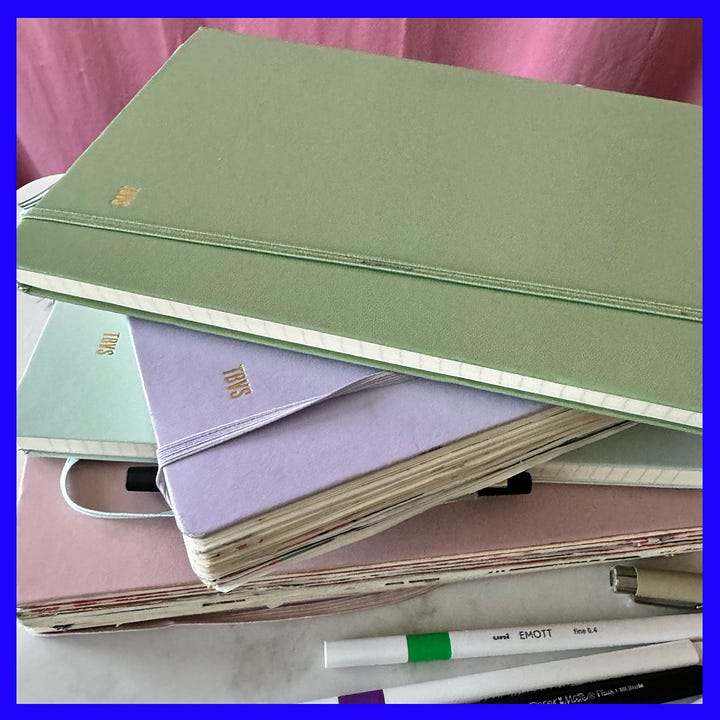
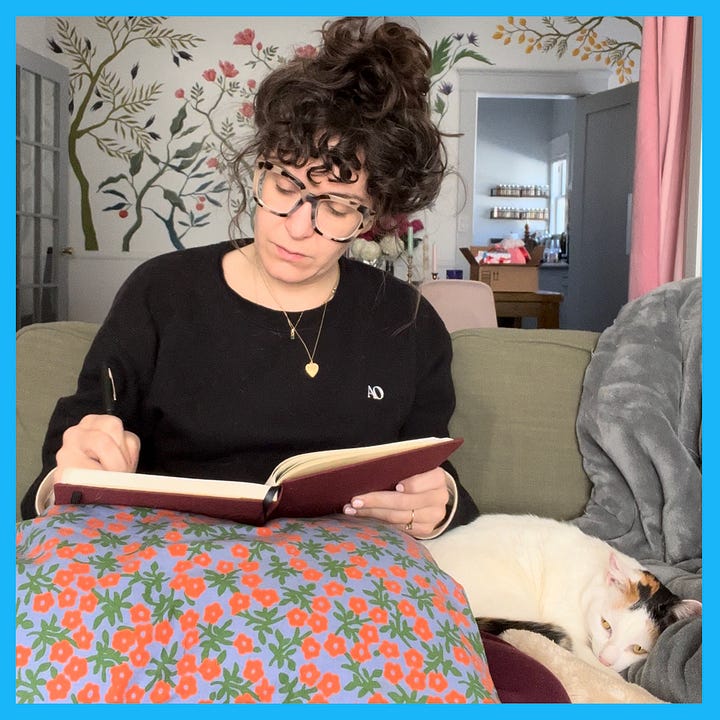
The official bullet journaling website has TONS of techniques and breakdowns on how to use it, and a cursory glance at TikTok will reveal hundreds of thousands of videos about different spreads, layouts and styles of #Bujo techniques. (Pinterest and YouTube provide equally deep bujo rabbit holes.) But at the end of the day, it’s really just about choosing what works best for you.
I use bullet journaling as a companion to morning pages (I have two separate notebooks.) They scratch two different itches and I love chronicling my life and ideas in two diverse ways. What I include in my bullet journal spread for each month:
Habit Tracker: Habit tracking is the most effective way for me to stay on track and cultivate new routines. I check off little calendar boxes for each day.
Gratitude List: An ongoing list of a few things each day I’m grateful for
Daily Highlights: One sentence sharing my favorite moment from each day
Goals: Personal, Professional, Creative, Creator goals for the month
Intentions & Bucket List: My intentions for the month & fun things I want to try
Heart List: An ongoing list of everything I’m currently loving
Growth: Accomplishments, Discoveries, Small Wins
The thing I love about bullet journaling is how customizable it is while still providing structure. It’s an extremely effective way of planning and chronicalling your life without the pressure of long form writing.
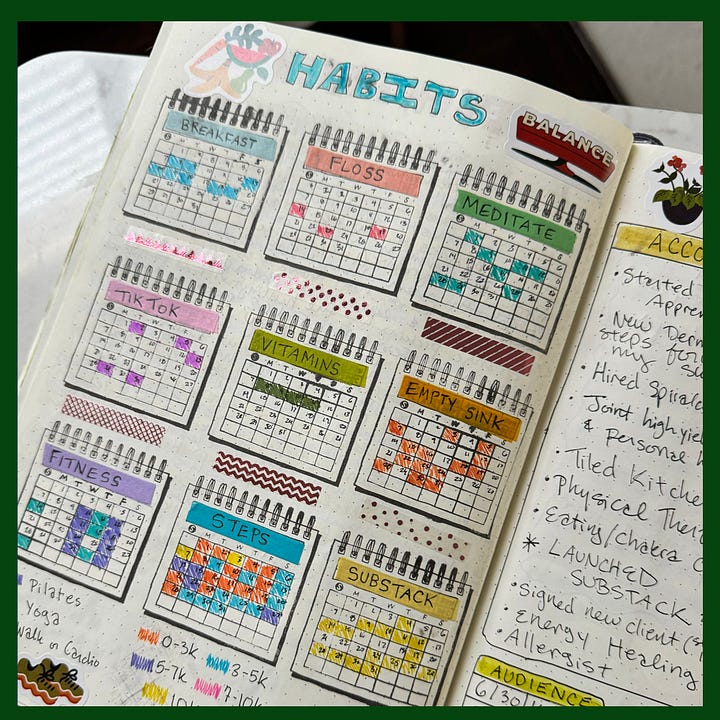
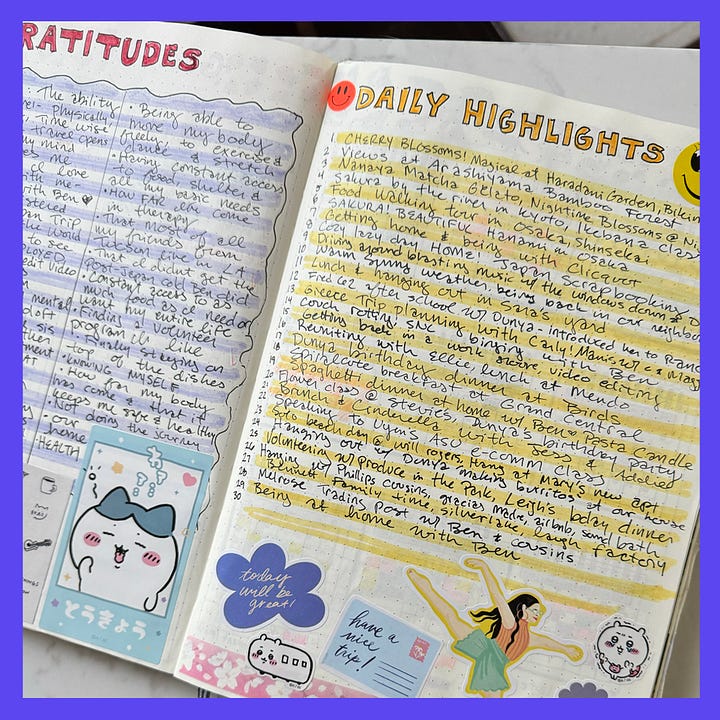
Here’s where my crafty girlies have their time to shine. The most visual of the three methods, this practice is a bit less journal, a bit more scrapbook, and wildly fun.
Junk journaling is a practice of collecting recycled materials and saving them as memories by collaging them into a notebook. It’s different from scrapbooking because it’s less precious and not photo-focused. It’s called junk journaling because it’s about turning “junk” into keepsakes. This can include receipts, labels, ticket stubs, wristbands, postcards, stickers, maps, brochures, newspaper or magazine clippings, polaroids, pressed flowers, product tags, you name it!
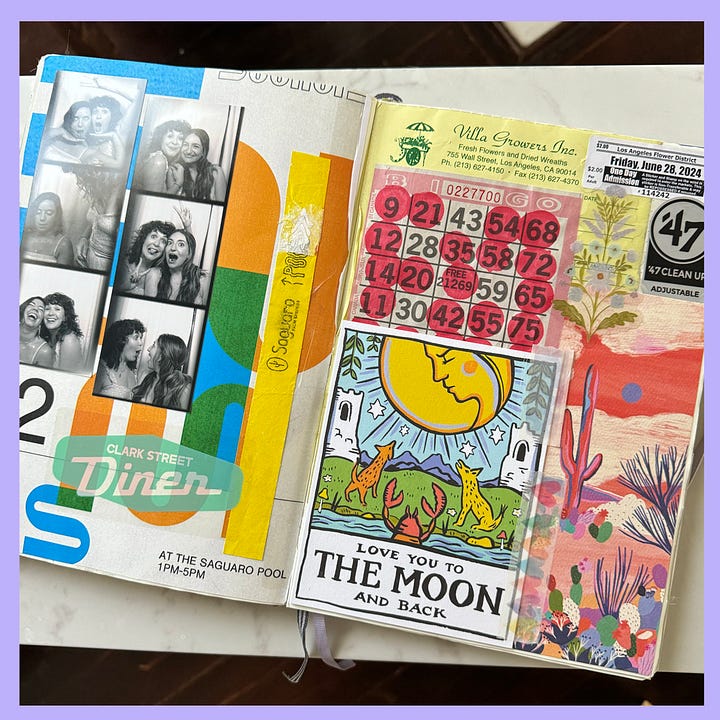

Junk journaling is SUCH a fun form of expression and a fantastic tactile hobby in a world of screens. I love to zone out, put on some music and fill up my pages. I especially love junk journaling traveling memorabilia. I find this practice extremely meditative and find myself in flow as I stick all the memories to the page. Its another form of healthy anti-perfectionism for me. Letting things be imperfect and messy and turning “unimportant” memories into keepsakes is so fulfilling.
There are sooooo many different ways to do this. (Another internet rabbit hole awaits you should you dive in.) Some people mix the junk into their regular journal, writing their thoughts and obersavations into it. Some use it as a space to share quotes or lyrics or even drawings and paintings. I keep my junk journal pages in my bullet journal, adding them to the back of each month.
At the end of the day, all you need to journal is a pen and a notebook. Period. That’s it.
….HOWEVER…. If you, like me, LIVE for any excuse to stock up on stationary or want some recommendations I’ve honed after years of journaling, here are my recs.
NOTEBOOK
I SWEAR by the Leuchtturm 1917 hardcover B5 composition notebook. It’s the perfect size and fantastic quality. I get mine monogrammed.
PENS
I am extremely idiosyncratic about pens. (And nothing else, obviously.) Ballpoint pens make me shudder. I always carry my own. Here are my favorites.
The GOAT. My one true love. The Paper Mate Flair felt tip. I buy it in bulk, always have a few in every purse, and will rarely write with anything else.
For bullet journaling, you need to make finer lines, so I use the Micron 01 Black marker felt tip pens.
My favorite highlighter pen is the Kuretake Zig Clean Color Dot Pens Water Based Marker.
For flair (and a hint of nostalgia) we love a Gelly Roll pen
For the habit tracking in my bullet journals I use the Emott Water-based Color 0.4mm Fine Felt Tip Pen
ACCESSORIES
For junk journaling you HAVE to have some adhesive tool. Glue sticks aren’t strong enough and get messy, regular tape is too clunky, so I strongly recommend stocking up on adhesive rollers.
I’m obsessed with my two-tier pen case I’ve used for the last three years.
Washi tape is another must (so are stickers!) you can find it everywhere, in gift shops, stationary sections, online. Just find ones that sing to you!
Which of these styles appeals most to you? Are you a fellow die-hard journaler? Or are you just starting out? Do you have pens I need to check out? Let me know all your journaling thoughts, questions and tips! 📚✨









What a gift this content is! The deep dive into Creative Journaling is amazing and inspirational. From Tarreyn continues to glow, shine, and enlighten so many wonderful things ✨️ 😊 thank you for all your offerings, examples, and DIY tips
Your guidance and insights are very welcome ✨️💕